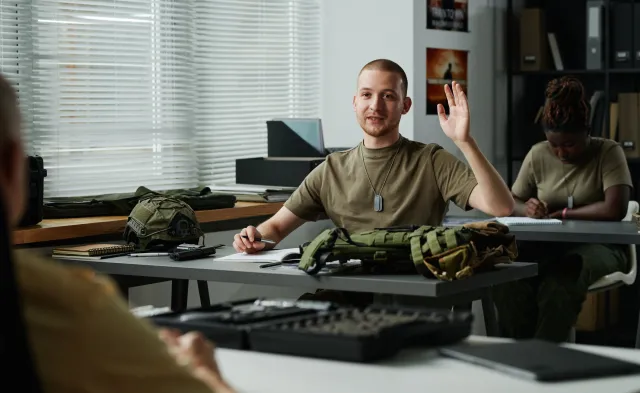Latest
How EMTs Prepare for Emergencies
Mar 29, 2021

Emergency situations can strike at any time and typically the first ones to arrive at the scene are Emergency Medical Technicians, otherwise referred to as EMTs. But it takes a lot of training and education for EMTs to be ready for just about anything they might encounter in the field.
In the Emergency Medical Services (EMS) field, EMTs primarily provide emergency medical care and transportation for patients from the scene of a crisis to a hospital. EMTs have the specialized training to use the ambulance equipment needed to stabilize and safely transport patients. Whether it is for a life-threatening emergency, non-emergency or routine medical transports, EMTs are trained for any situation. According to the National Registry of Emergency Medical Technicians (NREMT), they operate as part of a comprehensive EMS response system. They serve as the integral liaison between the site of the emergency and the healthcare system.
According to the Bureau of Labor Statistics, nearly 29,000 new careers are expected to be created for EMTs and paramedics between 2020-2030, an increase of 11 percent. EMTs need to complete a 16-week course, spend at least 50 hours on an ambulance and pass the NREMT exams to earn their license.
Leo Deason, Chair of the EMT/Paramedic Program at Herzing University, shared his insights on how EMTs are trained to prepare for the worst. Here are the three main disciplines that are essential in helping EMTs perform well under pressure:
Cognitive Discipline
The cognitive component of EMT preparation focuses on understanding theoretical knowledge. Although it is the most time-consuming, all healthcare professionals must excel in the classroom by actively listening to lectures and reading the textbooks.
“Cognitive is all about having the knowledge and knowing the numbers,” Deason said. “For example, how much aspirin do I give to a chest pain patient? EMTs should immediately have the sense of ‘I got it and know it’s 324mg.'”
Cognitive education is foundational for EMTs to provide safe and effective entry-level emergency medical care. In fact, students must pass the NREMT Cognitive Exam to be able to apply for their state license. “This national standardized test is used as the bridge between education and licensing,” Deason said. “It is an adaptive exam that tests students on the five key areas of EMS care that include: airway and ventilation, cardiac, medical emergencies, trauma, and operations.” To pass, students must meet a standard level of competency to make sure that they know the theoretical knowledge and feel prepared for on-site emergencies.
Psychomotor Discipline
The psychomotor component of EMT preparation is focused on building practical skills and applying cognitive lessons to patients.
“It’s basically like being a mechanic. We have to do certain things in a certain order,” Deason said. Looking at the human body like a blueprint helps to give EMTs an idea of where and how to start fixing the problem. Whether it be heavy bleeding or difficulty breathing, it is the responsibility of the EMT to stay calm and prioritize stopping the harm as soon as possible.
“It is also important for an EMT to recognize that if they do not have that ability, then they need to move to the next step which would be to transport the patient to a physician who can help stop the harm,” he said. Fast decision making and critical thinking are necessary skills for EMTs and they are especially relevant during psychomotor training.
Similar to the cognitive component, students are also required to pass the NREMT Psychomotor Exam to be able to apply for their state license. “Specifically for Alabama, students have to pass both a Cognitive and Psychomotor exam,” Deason said. To pass this exam, students must demonstrate competence in a wide array of emergency-care skills to assure they are prepared for any situation.
Affective Discipline
Even though all EMT students are graded across all three spectrums, affective is the only discipline that is not formally tested, Deason said. The affective component of EMT preparation focuses on being professional and maintaining a good attitude on a shift. “If someone’s affective behavior is bad and negative, then we can kick them out of the program - even if they have a 99% average in the class,” he said.
Creating a professional, respectful and judgment-free zone is important for not only your fellow EMT but for the patient as well. A good EMT succeeds in cognitive and psychomotor training, while a great EMT is proficient in all three - cognitive, psychomotor and affective behavior.
Thinking about becoming an EMT? Check out Herzing University’s 20-month paramedic/ EMT training programs offered at our Birmingham, Alabama campus. “We educate our students really well by making sure that they know exactly what they are doing before they leave this building,” Deason said. “Our goal is to make sure they don’t have that moment in their career of ‘I wish I would have done better.’” This course trains EMT students to be more than a team player and show up every day well-prepared for any kind of emergency.
Learn More About Our EMT Programs
Bureau of Labor Statistics (BLS), U.S. Department of Labor, Occupational Employment and Wage Statistics 2023 / Occupational Outlook Handbook 2022. BLS estimates do not represent entry-level wages and/or salaries. Multiple factors, including prior experience, age, geography market in which you want to work and degree field, will affect career outcomes and earnings. Herzing neither represents that its graduates will earn the average salaries calculated by BLS for a particular job nor guarantees that graduation from its program will result in a job, promotion, salary increase or other career growth.
Latest
Recent Blog Posts
Subscribe to our Newsletter
Get the latest news you need to know, from study hacks to interview tips to career advancement. Have it delivered right to your inbox biweekly.








